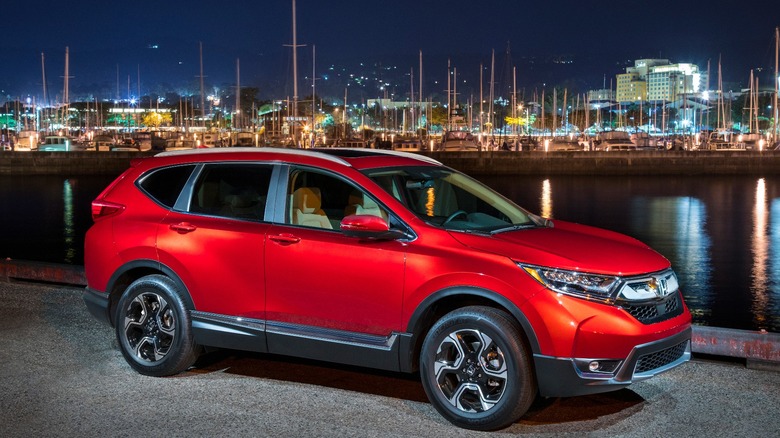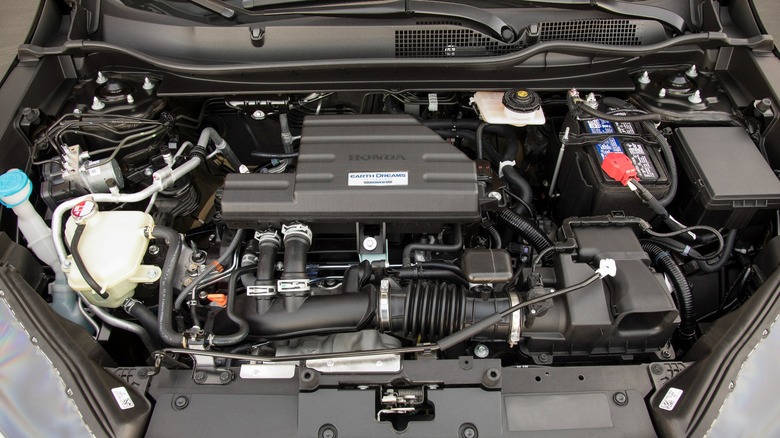Honda 1.5L Vs. 2.4L Engine: Which Is Better If You're Buying A Used CR-V?
The late 90s saw the beginning of the compact crossover SUV craze and included the Honda CR-V. Lauded for its combination of cargo space, adaptability, and nimble ride, the CR-V is a popular choice for drivers. In 2023, Honda sold 361,457 units in the U.S. alone, per GoodcarBadcar.com. So naturally, in terms of purchasing a used vehicle, one consideration is the best years to buy a Honda CR-V and the ones to avoid. But there are some other considerations to make when looking at previous production models. For example, should you get the 1.5L turbo engine configuration, or the naturally aspirated 2.4L?
The CR-V featured a redesign in 2017, and through 2022 offered a 2.4L four-cylinder engine in the base model and a 1.5L turbo variant in the upper trims. Turbocharging transforms engine performance, but it isn't without some downsides. The turbo option provides a few extra horsepower but offers slightly less torque than the naturally aspirated 2.4L engine. When comparing EPA milage estimates, the difference is only a couple miles in favor of the 1.5L, so nothing dramatic. The question then becomes, which engine is more reliable?
Unfortunately, it's difficult to say for certain which configuration is superior in the long run. However, turbocharged engines do include more parts than naturally aspirated ones, commonly need additional maintenance, and may ultimately cost you more.
Performance and efficiency
There's a reason that turbocharged engines are showing up more and more under the hood of modern vehicles: automakers can craft a smaller engine but still include robust performance. The 2017 CR-V with a 1.5L Single-Scroll MHI TD03 Turbo generates a respectable 190 horsepower as opposed to the 2.4L that produces 184 horses. One expert reviewer explained, "The CR-V [turbo variant] is quicker than most competitors, providing good low-end oomph for scooting through city streets."
However, another outlet described the naturally aspirated option as "a smooth and peppy 2.4-liter inline-four," but did note the turbo option was faster. But if you plan to tow anything with your CR-V, the larger 2.4L engine would be a better choice than the smaller turbocharged option.
In terms of fuel efficiency, the smaller turbocharged CR-V wins, but not by as much as you might think. The EX, EX-L, and Touring trims that include turbo offer a combined EPA estimated 30 mpg. The larger non-turbo engine configuration is rated for a combined EPA figure of 28 mpg, a difference of only two. No matter which CR-V model you choose, it's wise to incorporate the best ways to use less gas while driving for optimal fuel economy.
Engine stress and costs
While there is nothing quite like that jolt of acceleration when a turbocharger kicks in, it does put more strain on your vehicle and can result in additional maintenance over the long term. Aggressive acceleration is the moment when a turbocharger applies the most stress under the hood, such as when merging onto the highway. However, specialty tuning can mitigate the pressure on the engine, only applying extra force when necessary.
Saving money is always a priority and the 1.5L turbocharged engine may end up pulling more money out of your wallet. An engine with turbo has more parts than a naturally aspirated one, and with more parts, you may experience more problems. The 2017 CR-V for example, has received 465 NHTSA complaints for engine problems, including gas mixing with oil, per CarComplaints.com. According to one automotive expert, "oil dilution [gas mixing with oil] actually happens on all engines but unfortunately on these Honda one-fives it's happening at a higher rate than what is allowed."
To achieve a powerful engine that still met emissions standards, Honda crafted the 1.5L turbo, that while remarkable in many ways, it does have some drawbacks. According to Shadetreeautomotive.net, "It's set up to be able to run at a lower operating temperature, plus having the turbo, so it gives great power. However, the lower operating temperatures, turbo pressure, and mass amount of fuel pressure that isn't getting burned off enough is what's causing the bulk of this oil dilution issue."


